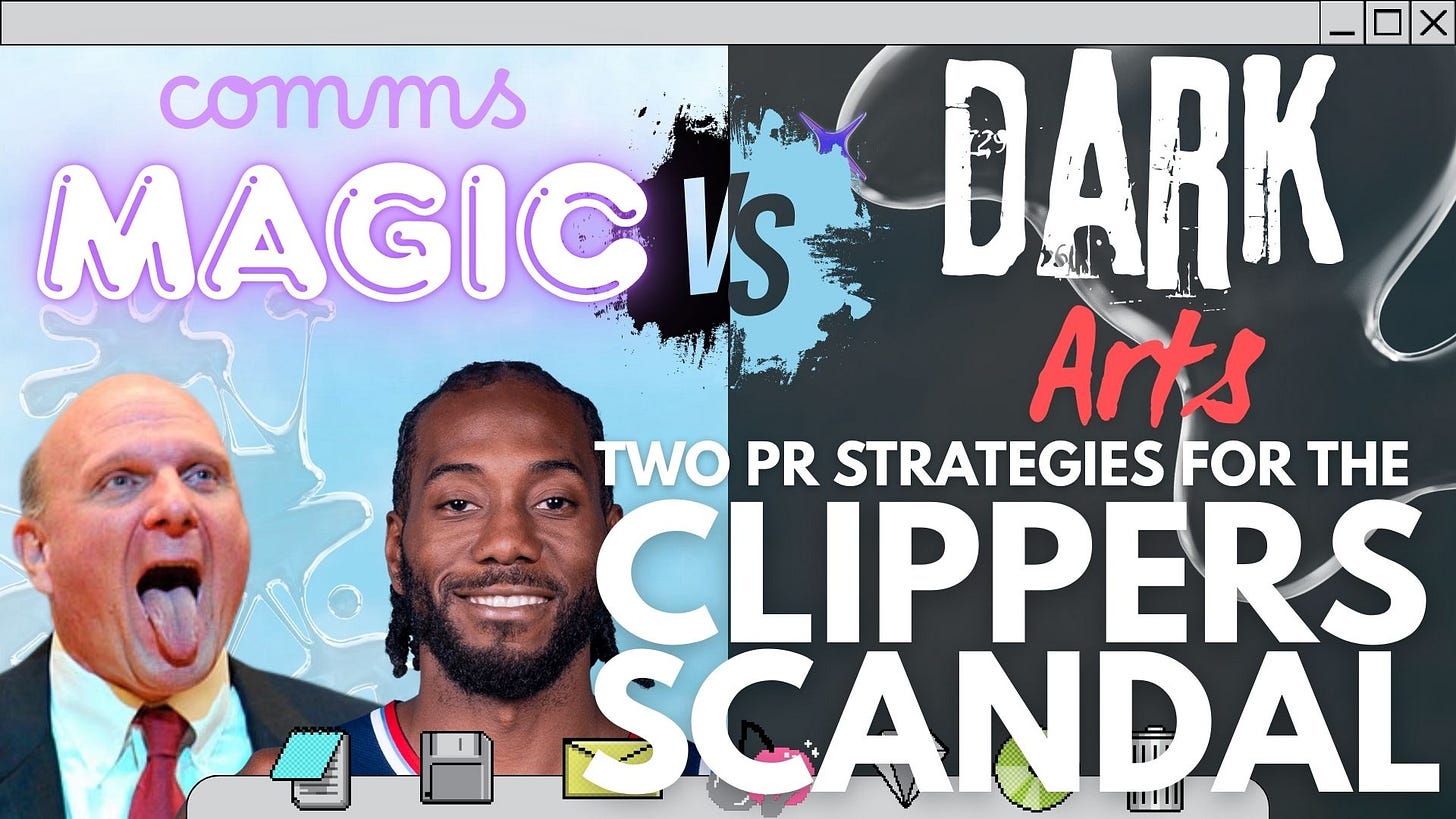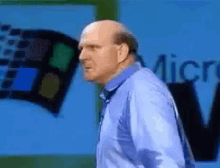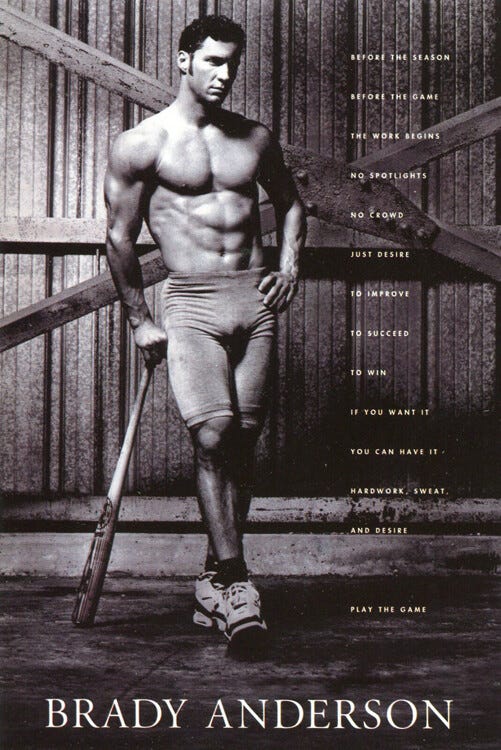Comms Magic & Dark Arts: A PR Toolkit for Steve Ballmer and the Los Angeles Clippers
A billionaire basketball owner might have more dirt in his past than anyone suspected, and an oft-injured superstar might find more reasons to stay benched. Is there a PR path out of this mess?
Welcome to Comms Magic & Dark Arts, a new, semi-regular Failure to Communicate feature wherein we scrutinize a PR crisis case study and explore ways to guide our theoretical clients through it, first using standard best practices (the “Comms Magic”) and then using less savory, some-might-say underhanded dirty tricks (the “Dark Arts”).
By reading CM&DA, you hereby absolve Failure to Communicate, All Points West, David Quiñones and/or any of their associates of responsibility for any negative career or reputational ramifications suffered by you or your clients because of your stupid choice to do any of this stuff.
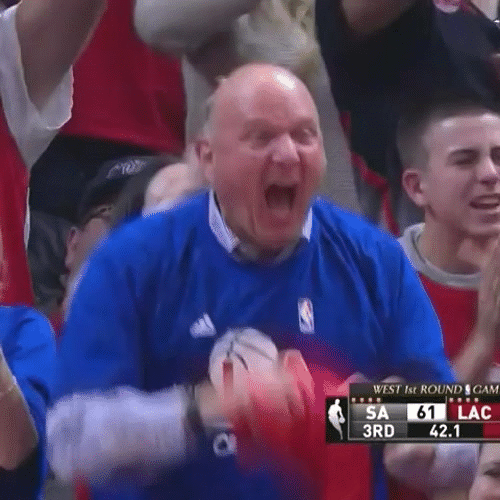
This week, CM&DA casts its gaze westward to Los Angeles, where billionaire NBA owner and world’s oldest toddler Steve Ballmer is sweating like it’s 1999.
For the uninitiated: 11 years ago, Ballmer, the former-Microsoft CEO, purchased the NBA’s Los Angeles Clippers for $2 billion. The sale was historical in value and controversy, as Ballmer’s seller was Shelly Sterling, the straw-owner of the team who was signed over its executive authority by her husband, California businessman and all-around sleazebag Donald Sterling.
Donald Sterling was sort of an urtext to the Me Too movement. In 2014, after a series of leaked recordings from his mistress outed him as a racist, homophobic, manipulative asshole, Donald faced mounting pressure to sell the team (through Shelly, to whom he had slyly conferred ownership). The NBA’s owner-in-waiting was Ballmer.
I’m really giving this story short shrift because, while juicy, it’s not our scandal. FX made a mediocre miniseries about the whole saga last year wherein Ed O’Neill played Sterling. It was called “Clipped”. You can skip it.
Fast-forward a decade and Ballmer has brought the moribund Clipper franchise to the doorstep of relevance, thanks to a dynamically constructed team led by superstars James Harden and Kawhi Leonard, a shiny new $2 billion stadium, and Ballmer’s legendary maniacal and enthusiastic management style.
Leonard, aka “The Klaw”, came to Los Angeles in 2019 after leading the Toronto Raptors to an unlikely NBA title. His free agency signing was seen as a coup for Ballmer and the Clippers, who have long occupied lil’ bro-status in LA, playing in the shadow of the far more successful Lakers. In the ensuing years, Leonard has disappointed fans with a litany of injuries and “load management days”, but that’s not really germane to our story.
The Crisis: Show Me the Money (Just Don’t Talk About It)
Here’s where we get to our scandal. In the summer of 2019, Leonard was widely considered the most consequential free agent on the market in years. Every team wanted what the Klaw was selling, and if contemporaneous reporting is to be believed, some made larger and/or longer contract offers than Ballmer, who is the richest owner in all of sports.
At the time, the prevailing wisdom was that Leonard probably opted to take less money because of the size of the media market – despite the fact that Leonard is a notoriously media-averse, quiet player who allows his uncle, agent, and business advisor Dennis Robertson, to do all his negotiations.
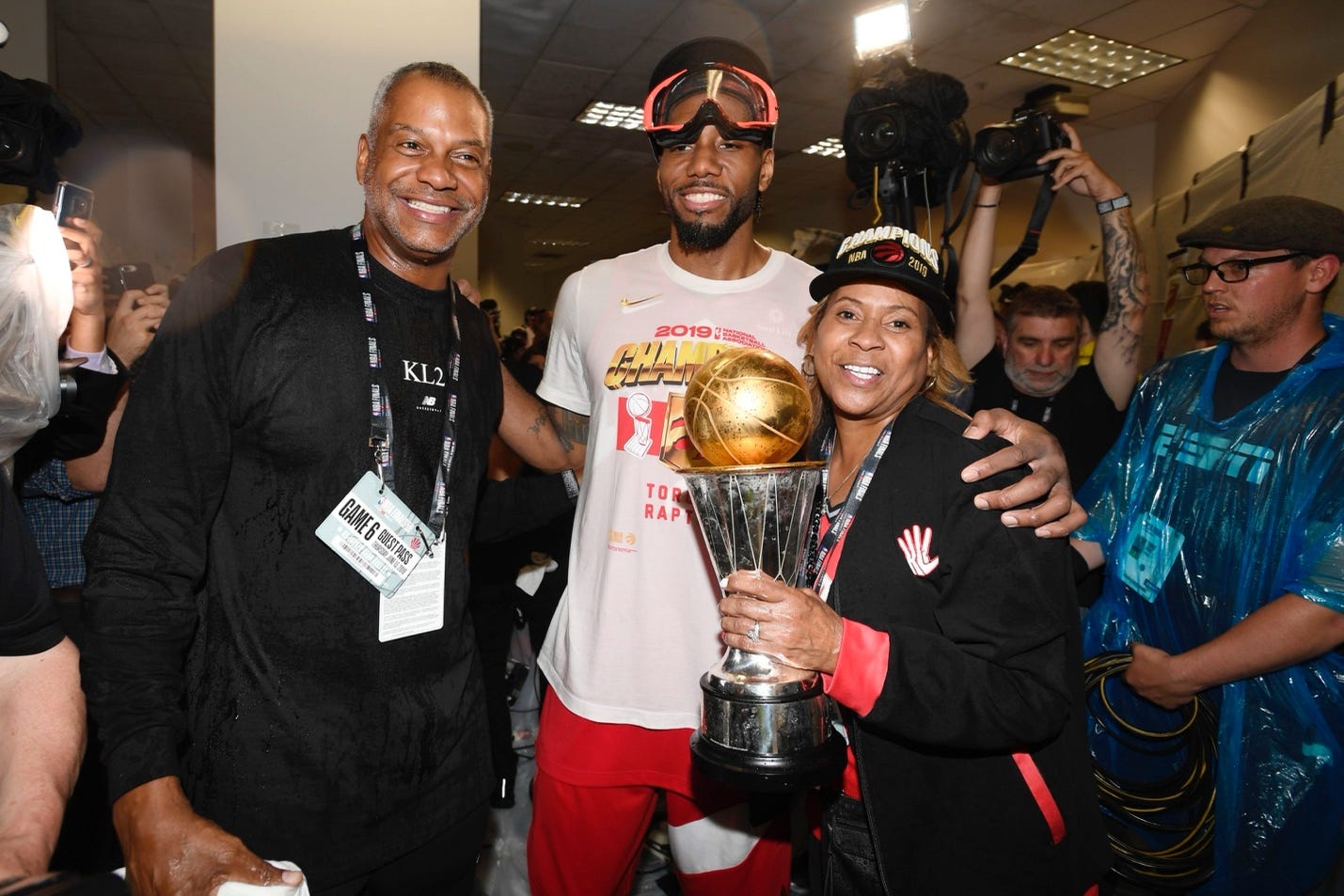
This month, it was reported by Pablo Torre that the Clippers orchestrated a $28 million “no-show” endorsement deal so that Kawhi Leonard would receive payments from Aspiration, a now-bankrupt sustainability/financial firm hocking carbon offsets partly funded by Ballmer. The deal allegedly required virtually no promotional work or public appearances by Leonard; its main obligation was keeping him under contract with the Clippers.
Aspiration filed for bankruptcy amid separate fraud accusations. Some internal documents reportedly show Aspiration still owes Leonard $7 million under this deal.
If true (and, like, come onnn…) this arrangement could constitute a violation of the NBA’s salary cap rules. The cap is about the perception of fairness, intended to limit what teams pay players through their official salaries; side deals or hidden payments that act like salary without being counted under the cap undermine that framework. While all NBA owners are obscenely wealthy, there are levels – even at that level – and a guy like Ballmer is final boss-level.
Because Ballmer had invested heavily in Aspiration, critics argue there may have been a conflict of interest or even active coordination to structure payments that would appear legitimate (as endorsements or sponsorships) but in effect serve to increase Leonard’s compensation outside of cap limits. The lack of transparency around the deal, and how much work (if any) Leonard performed, raised red flags internally, according to former Aspiration employees who spoke with Torre.
As this scandal has quickly became the biggest story in sports, the Clippers and Ballmer have strongly denied wrongdoing, calling the claims “absurd” and “provably false,” maintaining that Ballmer had no knowledge of the specific endorsement agreement. However, they still have not “proven” the claims “false”. Rather, further reporting by Torre has chipped away at the organization’s counterclaims.
Meanwhile, the NBA has opened an investigation into the matter. Possible penalties, depending on how the deal is judged under the collective bargaining agreement, could include fines, voiding parts of contracts, or loss of draft picks. While the allegations are still just allegations, the court of public opinion – you know, people with two eyes and a brain – have mostly arrived at the conclusion that there was foul play.
For NBA fans (like me) this is profoundly troubling, as it is the kind of underhanded “fix” many of us have always suspected is at play – and now there’s way more smoke.
Let’s Do Some Comms Magic
This scandal is multi-faceted, implicating not just Ballmer but a cofounder of Aspiration and a board member (both arrested on federal fraud charges), an NBA franchise that employs about 500 people, an NBA superstar and his uncle, and the entire Democratic Party. (Joe Sandberg and Andrei Cherny, Aspiration’s cofounders, were political movers-and-shakers who had the Clintons and Obamas on speed dial. They relied on that rolodex to find likeminded investors like Ballmer, a Dem donor and party supporter.)
That’s a thorny scandal, but it also gives us a wonderful opportunity to find a toehold in a lot of different, creative vectors to execute our Magic strategy.
Let’s get into it.
Magic Strategy
Our tone will be calm, transparent, and fact-based. There are already so many voices who have gas-bagged ad nauseum about this scandal, that we will provide a counterbalance with language that tones down rhetoric.
Our key messaging will rely on facts:
· “Steve Ballmer had no involvement in structuring or approving Kawhi Leonard’s endorsement deal with Aspiration.”
· “The Clippers organization and Mr. Ballmer fully support the NBA’s review and are cooperating completely.”
· “Mr. Ballmer’s investments are managed independently and at arm’s length from the Clippers’ operations.”
· “Transparency and integrity are hallmarks of both Mr. Ballmer’s business career and his stewardship of the Clippers.”
· “The organization remains focused on building a championship culture on and off the court, with full respect for league rules.”
· “And with respect for those rules and the process they govern, we will not make any further public statements at this time.”
This simple, clean, standard, out-of-the-box framing hews to the truth and stresses the importance of allowing the process to play out and reserving judgment.
From the things we say to the things we do, let’s consider some activations that dovetail with our messaging.
· The First Truly Transparent Franchise Audit in League History: From the New York Knicks winning the Patrick Ewing lottery in 1985 to the Tim Donaghy refereeing scandal in the 2010s to today, much of the NBA fandom’s obsession with rule-breaking scandals fixates on things that happen behind closed doors. So, let’s open them.
Along with two of the Big 4 as independent auditors (my recommendations would be Ernst & Young and Deloitte, IYKYK) our client will open the books, the ledgers, the tills, the filing cabinets – everything, every dollar and cent, all in the name of radical transparency. All findings and reports will be published online for open-source sleuths to pick through at their leisure, and Ballmer will empower independent brand ambassadors like super-fans “Clipper Darrel” and official media to question him on their own platforms. These opportunities will be vetted for fairness and friendliness.
We’ll use the findings to create content that distances the mainstream narrative from the originating scandal. The Clippers spend HOW MUCH on straws? An NBA TV deal pays THAT each season? They pay their parking vendors HOW MUCH? The audit creates a veneer of transparency and simultaneously provides grist for the talking heads to jabber about other less scandalous topics.
· The YouTube/podcast circuit: While our forward-facing influencer/podcast friends will be helpful, they are “owned media” at the end of the day. We need our campaign to break containment of our LA-based buddies; we need to get Ballmer on shows that will allow him to preach to converts, not choirs.
The sad reality is that most of the “new media” is not like Torre – rigorous, steely-eyed, ink-stained journalistic wretches on a quest to afflict the comfortable and comfort the afflicted. Most new media figures are comedians or social media influencers or Disney stars-turned-amateur boxers, and most of them just want to hang out with rich guys.
Hey, we’ve got a rich guy! Now, we don’t want Ballmer to go full-2024 Mark Zuckerberg-on-Rogan and morph into some weird manosphere-coded parody of himself, but there are plenty of other ways for Ballmer to stay true to his brand while reaching millions of new eyes and ears.
· Formal dialogue with the league office: A select task force of Clippers leadership and a player representative (I nominate the estimable Patty Mills) will establish a communication channel with the NBA as it conducts its investigation. This task force is charged with effecting two-way communications, sharing information with the league office while also updating the Clippers organization.
· The community aspect: Ballmer is no stranger to philanthropy, which is good, because deserved or not his reputation is going to require him to work that muscle set. And not just his check-writing hand – Ballmer will need to personally show face across Southern California to smooth over the bad feelings.
Fortunately, there are no real “victims” of this scandal. No one was hurt. It’s not like the Clippers ever won anything at some other team’s expense – if anything, they lost on the Leonard deal before the scandal broke. Without those sensitivities at play, the recipients of Ballmer’s largesse are less important than the optics of him giving.
We will undertake a historic team giving campaign to deepen already existing roots within the community. The parties and details can be hashed out by the L.A. Clippers Foundation, but what matters is 1.) the activations are on-the-ground (no fancy balls or galas) and 2.) Ballmer himself is in attendance, visible and accessible.
· Leverage All-Star Weekend: This coming season will mark 75th NBA All-Star Game, and wouldn’t you know it? The signature weekend is slated to be hosted by the Clippers and their shiny new Intuit Dome.
What better opportunity to show off that incredible community investment than All-Star Weekend? Leveraging media that we’ve captured via philanthropy, highlighting those freshly burnished community roots, and telling the story of a team that cares about its city with our client positioned as the main character, All-Star Weekend will be the coup de grace for the story we’re trying to tell about what the Clippers actually do – not what one podcast reporter claims they are.
And Now… The Dark Arts
Let’s take a quick dark arts inventory:
· Our client: Steve Ballmer. Not not Kawki Leonard, not Uncle Dennis, not Aspiration, not the Democratic Party, not the NBA. We are working to further Ballmer’s interests.
· Our weaknesses: Every single circumstantial fact. Also, probably, the actual facts.
· Our strengths: All the money in the world, unlimited resources, and a lack of definitive proof.
Ultimately, if our client is Ballmer, we must work to mitigate his exposure, preventatively rehabilitate his reputation, and counter the narratives that are damaging his business interests. Our client is a giant of American business, a folk hero among the Patagonia-vested capital class. It’s not an overstatement to say Ballmer’s name will be taught in MBA courses for decades to come. The work we do here will be reflected in the first lines of a front-page New York Times obituary one day.
Helping kids and the less fortunate is nice, and we can hope our Comms Magic obscures some of these allegations, but if we’re being ruthlessly efficient, we need to find a way to disappear this story from the front of the media mind. Or, maybe drown it out.
Let’s start with a model for our goal: Brady Anderson. We want Steve Ballmer’s Kawhi scandal to be Brady Anderson. “Hey DQ, who the heck is Brady Anderson?” Who, indeed.
At the epoch of baseball’s scandal-plagued steroid era, anyone with two eyes could look at ultra-jacked stars like Mark McGwire, Sammy Sosa, and Jose Canseco and know that something was up.
One of the first clues that got the baseball literati buzzing was in 1996 when a skinny, pinup model Baltimore Orioles outfielder named Brady Anderson exploded for 50 home runs, nearly triple his career high to that point in his career. The power surge happened when Anderson was 32, an age when most ballplayers have already begun to see a decline in production. The implication – and I want to stress it was only ever that – is Anderson’s season was powered by performance enhancing drugs like steroids or human growth hormone.
I’m not sure if it’s possible for Ballmer to get the Brady Anderson treatment, but if investigative reporting got us into this mess, maybe it can get us out.
A couple years later was the famous yearlong home run derby between Sosa and McGuire that ushered in a brief resurgence of America’s pastime, and shortly after that the larger public added “performance enhancing drugs” or “PEDs” to its lexicon. Today, when we think back about that era, we think of home run king Barry Bonds whose personal scandal eclipsed the entire sport for years. Only true ball-knowers remember Anderson’s name.
Like our client, no definitive, smoking gun proof was ever published that Anderson was juiced – in fact, there’s a plausible case that he wasn’t. Ideally, our client’s name will be a “Brady Anderson” in this era of NBA dark money – or at least not the Barry Bonds of the whole imbroglio.
I’m not sure if it’s possible for Ballmer to get the Brady Anderson treatment, but if investigative reporting got us into this mess, maybe it can get us out.
Dark Strategy
Anyone reading between the lines of public statements by current and former NBA players and executives can pick up on one theme: the Kawhi Leonard scandal is not an isolated incident. (Oh by the way, we’re also making sure to refer to it as “the Kawhi Leonard scandal” from now on, not “the Clippers’ scandal” and definitely not “the Steve Ballmer scandal”.)
Leveraging our strength (an enormous mountain of money) we will not try to hide from the allegations that shadow money contracts exist in the NBA. Rather, we will root out and report on all these deals, surfacing them to the public awareness to create distance between our client’s scandal and the next juicy scandal. When people write the book about this era, our aim is for Steve Ballmer and the Clippers to be brief early entry, a footnote, a “Brady Anderson.”
Here’s how:
· Shadow newsroom: We will fund and stand-up a shadow newsroom of investigators and out-of-work journalists to collaborate with well-sourced media relations pros who will feed their clandestine reporting to mainstream outlets (maybe even Torre himself). We will need to obscure the source of the reports, of course, because the existence of this newsroom will raise its own questions. The dissemination of these tips and leads will need to be carefully handled, as their provenance will also be interrogated.
It would be best to contract a firm that works with the league on the periphery, as opposed to better-known agencies. Familiarity-and-distance is the profile we’re seeking. The folks staffing the newsroom will be precluded from being read into the true nature of their work and, if we’re being careful, they won’t even be aware of who they’re working for.
The shadow newsroom’s work product will be un-bylined until it is handed off/tipped off to unaffiliated journos who, presumably, will run with each new story. NDAs all around.
· This town ain’t big enough for two scandals: As news cycle after news cycle drags on and your brand stays under the microscope day after day, these controversies can often feel interminable. It’s important to remember that they’re not, and that eventually you will be bumped from the front page.
In this case, we can see the next controversy looming in the middle distance. L.A. is a wonderful city – one of my favorites – but it is dealing with a unique set of social, political, and structural challenges as it prepares to host the 2026 World Cup and the Games of the XXXIV Olympiad in 2028. As World Cup and Olympic fever take hold of Southern California, new narratives will emerge.
Already, human rights monitors are concerned about the actions that city and state officials might take to, ahem, “hide” the less desirable traits of a city struggling with food and housing insecurity, homelessness, poverty and crime.
With our media outreach resources and, again, enormous piles of money, we will amplify these stories of international import – shunting aside the relatively unimportant questions of which injured small forward did or didn’t get paid to hock carbon offsets 6 years ago.
· Targeted discourse dampeners: Earlier I alluded to the existence of the so-called “Player Podcasts”, popular online shows that feature outspoken retired players and entertainers whose status affords them a platform to speak candidly about the league.
These shows are the modern drivers of NBA fandom discourse, and by focusing our messaging on them via quieter influence like the dissemination of fam trips, inclusion in glitzy media events, and third-party sponsorship opportunities (we already know Ballmer knows how to do these!) we can curry favor with a group of influencers who, frankly, are not bound by anything resembling journalistic ethics.
· Sorry, Kawhi. Later, Uncle Dennis: Remember, our client is Steve Ballmer, who still maintains that he knew nothing of this financial arrangement. However, Leonard and his camp cannot make such a claim. They knew they were getting paid.
If push comes to shove, an options exists for the blame to placed on Leonard and, specifically, his Uncle Dennis, who has a long and storied reputation of doing what it takes (and sometimes doing too much) to extract concessions from NBA teams.
Pinning the scandal on Leonard’s camp is yet another tactic that will require a third party to execute, and it is far-and-away the highest risk of any option outlined here. If it ever came out that an NBA owner was tossing a player under the bus like that, the ramifications would make it difficult for that team to ever sign a high-profile free agent again.
· The Nuclear Option – Acquisition: Look, there’s only one journalist actually pursuing this story and not merely aggregating existing reporting, and it is the venerable Pablo Torre of the eponymous Pablo Torre Finds Out podcast.
Torre’s show is co-owned by him and Meadowlark Media, a podcast network founded by former ESPN chief John Skipper and sports personality Dan Le Batard. The company launched with a $12.6 million funding round in 2021 and has secured sponsorship deals with Draft Kings in the neighborhood of $50 million. (Hey, for a bag like that you could hire two Kawhi Leonards to not show up for your fake sustainability company!)
These numbers sound big to you and me, but to a guy like Steve Ballmer it’s couch cushion change. Why not just buy Meadowlark, cut a check for $100 million? Ok, ok, I can hear you shouting that a transaction creating such an egregious conflict of interest would stir public outrage. To that I say, yeah, maybe a few years ago, but the present finds us in a world where pump-and-dump schemes and “rug pulls” have become so commonplace that our own President and First Lady have orchestrated several of their own this year. This is a hopelessly cynical moment, and those who succeed will be those who abandon all hope and embrace cynicism.
Campaign Post-Mortem
On a long enough timeline, nothing is a crisis. This dark money NBA scandal is probably not the only one of its kind out there brewing. And there are difficult, messy conversations to have about how pervasive and intangibly sinister this entire issue of invisible compensation is for major league sports.
On a long enough timeline, nothing is a crisis.
The 15% Rule® that I just made up in my head right now asks us to imagine if a grift was done by someone 15% smarter, or who worked 15% harder to hide it, would they have gotten away with it? In this case: Yes. Kawhi could have simply shown up once or twice for photo shoots or community events. Ballmer could have concocted a more plausible scenario for his investment. The Aspiration leadership could have covered their tracks a little better. This scandal only came to light because it was done semi-incompetently. Hey Steve, next time call your crisis management guy beforehand.
I hope this first entry in the Comms Magic & Dark Arts compendium has provided a resource for any morally upright or morally bankrupt comms professional to navigate their billionaire client through the choppy seas of (maybe) supplementing his NBA team payroll with corruption and (allegedly) grafting the principals of a quasi-scam to do it with (hopefully) minimal brand impact. I hope you learned something. I hope you realize that Comms Magic & Dark Arts isn’t about getting you to try these underhanded tactics, but to improve your comms literacy and recognize when you inevitably see them being executed – which they absolutely are.
But more than anything, I hope you don’t actually try any of these Dark Arts yourself unless you have your own crisis management plan in place.
And to Steve Ballmer, feel free to take any of these strategies and implement them without attribution if it helps more quickly move past this whole mess. Either that, or wait for the Lakers to win another championship and knock you off the front pages for a few more years, lil’ bro.



